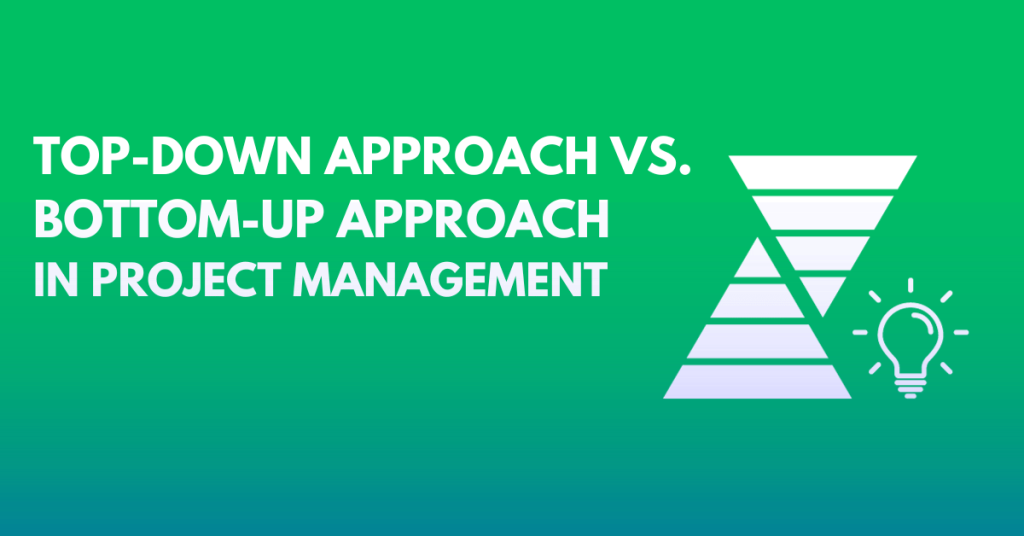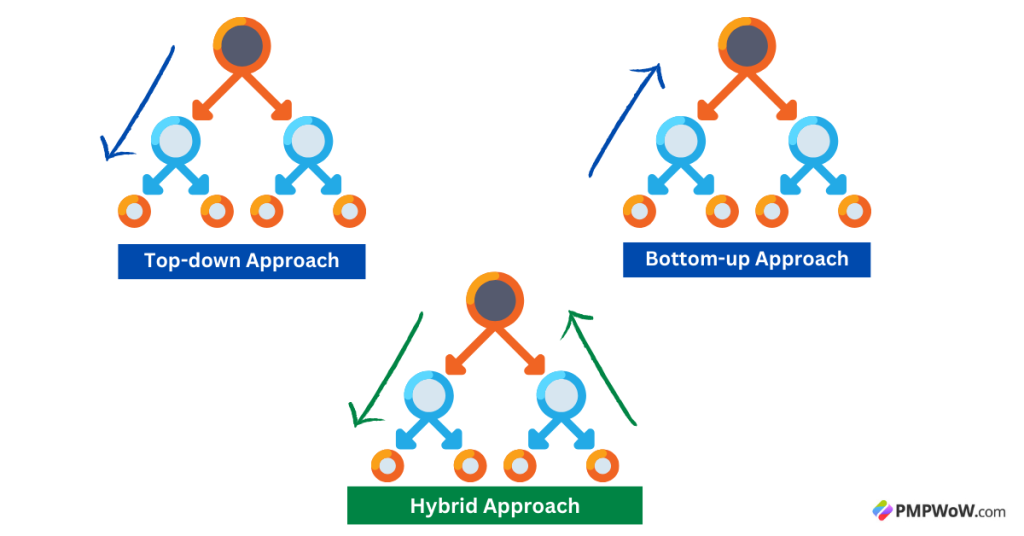
Project management is like guiding a ship through stormy waters. The captain must decide: does he set the course from the bridge or let the crew chart the path? Similarly, in project management, there’s a choice between top-down and bottom-up approaches. Each has its merits. Picking the right one can mean smooth sailing or hitting rough seas. This article is going to explore these two methods. I’ll explore their advantages and disadvantages, too. So, this content will support you in deciding which is best for your projects. Read on! Let’s explore all the facts behind the top-down approach vs. the bottom-up approach in project management.
Definition and Overview
Top-down Approach
In the top-down method, decisions start at the highest level. Leaders or senior managers set the main goals. Then, these goals break down into smaller tasks for teams to execute. The top-down approach’s key characteristics are:
- It is a centralized decision-making method. Leaders play a big role.
- It has a broad view. Focus on the big picture first.
- Information flows from the top layer to the bottom.
Bottom-up Approach
Here, the process flips. Team members or lower-level employees begin with specific tasks or ideas. These then combine to form the bigger project goals. Bottom-up approach’s key characteristics are:
- It is a decentralized decision-making method.
- Teams (bottom) have a big approach to decision-making.
- It has a detailed view that starts with small tasks or goals.
- Information gathers at ground level and moves up.
In the world of project management, these two methods stand tall. Each has its place, and knowing when to use it can set a project on the path to success. In the following paragraphs, let’s explore their unique features and how to choose the best approach for your project.
Key Differences Between two approaches
Let’s uncover the distinct differences between top-down and bottom-up approaches in project management. Understanding these differences can guide project managers in choosing the approach that best aligns with their project’s needs and organizational culture.
Decision-making process
- Top-down: Leaders or senior management typically make decisions. The process is hierarchical, with directives flowing from the top.
- Bottom-up: Decisions often stem from team discussions or lower-level employees, ensuring a more inclusive process.
Level of stakeholder involvement
- Top-down: Involvement is usually limited to higher-ups or key stakeholders.
- Bottom-up: A broader range of stakeholders, including team members and sometimes even clients, have a say.
Flexibility and adaptability
- Top-down: Changes can be challenging to implement due to their structured nature.
- Bottom-up: – More fluid and open to adjustments based on feedback or new insights.
Time and resource allocation
- Top-down: Resources are allocated based on the initial plan, which might not always account for ground-level realities.
- Bottom-up: Allocation is often more in tune with actual needs, as it’s based on input from those directly involved.
Scalability
- Top-down: – Easier to scale as the structure is clear from the outset.
- Bottom-up: This might require more effort to scale, especially if there’s a need to align multiple smaller initiatives.
Advantages and Disadvantages of Both Approaches
By considering the top-down approach and the bottom-up approach, those two have unique advantages and disadvantages. You should have a clear idea about those to select the best approach for your project. Let’s see.
Top-down Approach
Advantages
- Strategic alignment: This approach ensures that every project step aligns with the company’s main goals. It ensures unity in direction and purpose.
- Clear vision and direction: From the start, everyone knows the end goal. This clarity can boost team confidence and focus.
- Easier for large-scale decision-making: With a set plan from the start, making big decisions becomes more straightforward.
Disadvantages
- Can overlook details: By focusing on the big picture, there is a chance that small yet crucial details might get missed.
- Risk of miscommunication: With decisions coming from the top, there’s a chance of information getting lost or distorted as it trickles down.
- May not be as flexible to changes: If a shift is needed, this approach can be rigid, making adjustments tough.
Bottom-up Approach
Advantages
- Detailed and thorough: Every aspect of the project gets attention. It can be a plus to make the right decision faster.
- Encourages team involvement and ownership: Everyone has a say, fostering a sense of ownership and motivation among team members.
- Can be more adaptable to changes: With a more fluid structure, making changes based on feedback or new data is easier.
Disadvantages
- Can be time-consuming: Giving attention to every detail can stretch out timelines.
- Risk of losing sight of the bigger picture: With a focus on details, the overarching goal might get blurred.
- May face challenges in aligning with strategic goals: Ensuring every small decision aligns with the company’s main objectives can be challenging.
Choosing the Right Approach
Selecting between top-down and bottom-up isn’t a one-size-fits-all decision. It’s about finding the best fit for your project’s unique needs. Here are some factors to weigh in.
- Project size and complexity
Larger projects might benefit from a top-down approach for streamlined decision-making, while smaller, intricate projects might lean towards bottom-up for detailed insights.
- Organizational culture
Companies with a centralized decision-making culture might favor top-down. In contrast, those valuing team input might lean towards bottom-up.
- Stakeholder preferences
Some stakeholders might prefer a clear directive (top-down), while others might want more involvement in the nitty-gritty (bottom-up).
- Available resources
If resources are limited, a bottom-up approach might help in utilizing them more efficiently, ensuring every bit counts.
- Hybrid approach
Sometimes, blending both methods can be effective. It combines the clarity of top-down with the detail-oriented nature of bottom-up, offering a balanced way forward.

The Value of a Hybrid Approach in Project Management
A hybrid method, combining elements of both top-down and bottom-up approaches, often emerges as a powerful strategy. Here’s why!
Flexibility
A hybrid approach allows for a structured vision from the top while retaining the adaptability found at the grassroots level. It ensures that projects can redirect when necessary, adapting to new information or changes in the environment.
Inclusivity
By blending both approaches, a broader spectrum of team members gets involved in decision-making. This inclusivity promotes a sense of ownership and motivation within the team, driving projects forward with a shared sense of purpose.
Balanced Perspective
A hybrid model encourages a balanced view of projects. It ensures that the big picture is always in sight while the finer details are not overlooked, promoting a well-rounded understanding of the project’s objectives and pathways to success.
Resource Optimization
With a hybrid approach, resource allocation becomes more attuned to the project’s actual needs. It allows for a more dynamic distribution of resources. It ensures that each aspect of the project is adequately supported and can thrive.
Real-world Examples
Let’s see two real-world examples to understand those two approaches’ user cases clearly.
Top-down Approach
- Apple’s iPhone
Apple, under Steve Jobs, launched the iPhone with a clear vision from the top. The company set the direction, and teams followed, leading to a revolutionary product that changed the smartphone industry.
- The Manhattan Project
The U.S. government’s initiative to develop the atomic bomb during World War II was a top-down project. With a clear directive from the government, scientists and engineers collaborated under strict secrecy, leading to a breakthrough in nuclear technology.
Bottom-up Approach
- Linux operating system
Linux began as a passion project by Linus Torvalds. With contributions from developers worldwide, it grew organically. This bottom-up approach made Linux a powerful, open-source alternative to other operating systems.
- Wikipedia
Wikipedia, the free online encyclopedia, is a testament to the bottom-up approach. Instead of a centralized team creating content, volunteers from around the globe contribute and edit articles, making it one of the most comprehensive knowledge bases.
Hybrid Approach
- Microsoft’s Development Strategy
Microsoft often employs a hybrid approach in software development. Combining centralized planning with team autonomy allows for strategic alignment while encouraging innovation and adaptability at the operational level.
- Toyota’s Production System
Toyota seamlessly blends top-down oversight with bottom-up employee insights. This approach ensures that while organizational objectives guide operations, valuable on-ground insights from employees also play a crucial role in shaping processes and strategies.
Conclusion
Both top-down and bottom-up approaches offer unique strengths, and the choice between them isn’t black and white. It’s essential to consider the project’s nature, stakeholder preferences, and available resources. Sometimes, a hybrid approach might be the best option. As you move forward in your project management journey, remember that the key lies in adapting, learning, and choosing the method that aligns best with your project’s goals and the team’s dynamics.








